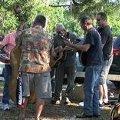Under weeping willows and oak trees, musicians gather to play bluegrass at a picking session in rural Cassia, Florida.
Guitarist and harmonica player Larry Testerman says it is a chance to get together with like-minded enthusiasts.
"You could call us just met, because some of us have just met," says Testerman. "But bluegrass is a common denominator that brings a lot of people together." The unique American roots music is often associated with the arrival of Celtic immigrants to the Appalachian Mountain region in the 1700s.
"When the Irish came over and settled in the mountains. They, of course, brought their string instruments and their music and their dancing," says Testerman. At this bluegrass jam there are no speakers or amplifiers. True to tradition, these musicians use only acoustic instruments.
J.J. Weis plays with a group called the Hilltop Ramblers.
"You look for a banjo, then you look for a flat top guitar, got to have the stand-up bass, a fiddle works really well, and then you get the old mandolin in because a mandolin really has got some good sound to it too." Musician Bill Monroe is often called "The Father of Bluegrass". The genre is believed to owe its name to Monroe's 1930s band, The Blue Grass Boys. These bluegrass pickers say they try to stay faithful to Monroe's style. But it is often fast-paced and complex, and some musicians admit they don't always succeed. "If we can bring some smile on people's faces - even if we don't do it exactly like it was done before - if they like it, that makes us happy," says Weis. This jam has been a fixture in this part of Florida for about 20 years. And bluegrass aficionados here hope it will continue for many decades to come.

